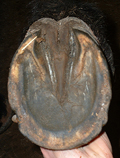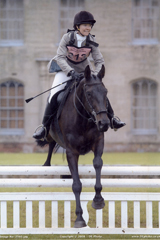Please do call me on 07990 973913 to ask any questions, to discuss any concerns you have, or to ask for more information, either generally or specifically about your own situation.
The answer to this is an essay in itself! However, here are a few key points, simply explained:
- The steel shoe will lift the hoof up off of the ground, and inhibit the frog and sole sharing the load of the horse with the hoof wall. This means the hoof wall, (and by transference the coronary band and laminae) will take the whole weight of the horse, which they are not designed to do, putting too much stress on these structures and eventually leading them to deteriorate.
- The main shock absorbers and all of the mechanoreceptor nerves in the horse’s foot are underneath the frog and in the back part of the hoof, so by lifting the frog in particular off of the ground, the horse’s ability to absorb concussion correctly is seriously compromised, along with the sensory information it gathers from the mechanoreceptors regarding hoof placement.
- In addition, the hoof is designed to be a flexible structure, which can distort in a three dimensional way upon impact – this helps to allow for optimum shock absorption and adjustment of balance. Steel is approximately 30 times less flexible than hoof keratin, so by attaching it to your horses hoof, it will greatly impede this flexibility and thus the correct function of the hoof.
- As well as not being able to be absorbed correctly, the concussion from landing is also much increased by the effect of the steel, but it still has to be dealt with somehow! This means that joints, tendons and ligaments take more of this concussion, as well as other structures within the hoof, so equilibrium of function is compromised because of the steel material along with the shape of the shoe and how it loads the hoof. This also has an adverse effect on circulation which has a significant role in shock absorption and brings nutrition to the hoof.
- Steel can also have a ‘crushing’ effect on the hoof (wall tubules) because of the mechanical differences in how steel and hoof keratin behave.

 Through lack of stimulation, a badly atrophied frog (and contracted heels) can no longer play it’s vital role
Through lack of stimulation, a badly atrophied frog (and contracted heels) can no longer play it’s vital role
2. Isn't barefoot just suitable for horses and ponies not doing much work?
No, with the correct management, conditioning and nutrition, almost every horse is ultimately capable of working without shoes. Depending on the condition of your horses hooves at the starting point, it may take as much as 6 months or so to get a good enough hoof to do higher levels of work, but work can be done in hoof boots to increase usability and work capacity whilst developing a stronger hoof. Once you’re horse has developed the hooves he or she needs, if necessary boots can also be used on an occasional basis to manage wear, or grow a bit of ‘extra hoof’ to take you through periods of hard work needing to be done.
 Lydia and Meg - National Riding Club Eventing Championships 2008
Lydia and Meg - National Riding Club Eventing Championships 2008
3. Horses that hack, jump and compete won't be able to do that with no shoes, will they?
Yes, there are many barefoot horses competing in every discipline! Along with the answer to the above question, one of the main mechanisms used in equine podiatry is that pressure is a stimulus for growth, so generally, the harder your horse works, the stronger and better foot he’ll grow, providing correct management and equilibrium of function within the hoof structures is set up to encourage this. Hooves can also adapt in shape according to the type of ground they need to work on – a horse working mostly on hard ground should develop a thicker, more infilled sole for protection and wear, whilst a horse on soft ground will have a more concave sole for more ‘dig’ and grip. A horse also uses his natural slip/grip to turn and will rarely fall over! Better biomechanics will be achieved without shoes, which can also mean more efficient movement and less injury risk. However, I should point out here, that at the higher levels of eventing and showjumping on turf, you may need the extra security of footing that shoes with studs would provide.
4. Surely my farrier can trim my horse to go barefoot, what's the difference?
It’s not just about the trim. Most farriers wouldn’t dispute that they have little or no training in nutrition, environment, or any of the other many factors affecting hoof health, and how these can be used to influence hooves. This is why an equine podiatry approach can work, where a farriery approach has failed, and also what you are paying for compared to the average cost of a farrier’s trim.
5. Is it cheaper to have a barefoot horse?
Yes and No! Initially you may have to spend money on hoof boots and pads to help with the transition to barefoot, depending on the starting point of the hooves and the work you want to do with your horse. A decent pair of boots costs on average about £90 - £120, but they should last at least a year or two, and probably will last a lot longer, again depending on the work you do in them. There is also a good market for second hand hoof boots. Pads usually cost about £12 per pair, and may need replacing intermittently. Our topical treatments tend to be inexpensive – e.g a pot of Sudocreme may set you back £5. The charge for a consultation and trim is £35. There may be an additional charge for travel outside of a 15-mile radius unless a few horses are seen in the same area. With a typical set of shoes costing anywhere between £60 - £90, I suppose the answer is yes, in the long term, it is cheaper.
6. My horse has really bad feet, it won't cope without shoes.
‘Genetics’ are often blamed for this one, and it’s true that some breeds have stronger feet than others. But millions of years of evolution have not produced a prey animal designed to roam many miles a day, having to use speed to escape predators, over massively varied terrain, with ‘bad’ feet which can’t do the job! It is our influences which compromise the hooves, whether by shoeing practices, nutrition or management – all usually done with the best of helpful intentions! You need to ask yourself why has your horse got bad feet in the first place?! Maybe it’s time to tackle the cause, not just treat the symptoms …
7. Effective treatment for conditions such as Laminitis, Navicular, Thin Soles, Under-run Heels... The list goes on... Why does taking the shoes off help?
Firstly, let’s remember that all of these conditions are symptoms produced
when something else is going wrong in the horse or the hoof and causing
the problem. Farriery tends to just treat the symptoms, achieving a short
term solution, whereas equine podiatry addresses the causes, which is much
more likely to lead to a long term improvement or recovery. For example:
A farriery approach to a horse with low underrun heels may be to fit some
wedges to artificially ‘lift the heels’. An EP would address the reason
why the heels are like that in the first place – probably due to incorrect
heel height and landing – the key to getting the heels better is to get
the horse to land correctly, so why was it landing incorrectly in the first
place?
We also need to take into account here the answer to Q1. ‘Why is it better for a horse not to wear steel shoes?’ and realize that as soon as the correct functions and relationships of each structure of the hoof are disrupted and no longer in balance with each other, the horse has no choice but to compensate by taking undue stress onto areas not designed to cope with this, which in turn creates problems. So by taking the shoes off, treating the causes not just the symptoms, and bringing the whole hoof into equilibrium of function with appropriate trimming and management, huge improvement can often be made. This also sets the horse up to use its remarkable natural ability to heal itself – but only providing we allow it to do so.
